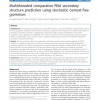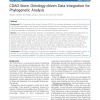BMCBI
2011
13 years 6 months ago
2011
Background: The Monte Carlo simulation of sequence evolution is routinely used to assess the performance of phylogenetic inference methods and sequence alignment algorithms. Progr...
BMCBI
2011
13 years 6 months ago
2011
Background: OmniLog™ phenotype microarrays (PMs) have the capability to measure and compare the growth responses of biological samples upon exposure to hundreds of growth condit...
BMCBI
2011
13 years 6 months ago
2011
Background: The number of gene sequences that are available for comparative genomics approaches is increasing extremely quickly. A current challenge is to be able to handle this h...
BMCBI
2011
13 years 6 months ago
2011
In the article, Scanner calibration revisited, BMC Bioinformatics 2010, 11:361, Dr. Pozhitkov used the Scanner Calibration Slide, a key product of Full Moon BioSystems to generate...
BMCBI
2011
13 years 6 months ago
2011
BMCBI
2011
13 years 6 months ago
2011
Background: Genome-wide single-nucleotide polymorphism (SNP) arrays containing hundreds of thousands of SNPs from the human genome have proven useful for studying important human ...
BMCBI
2011
13 years 6 months ago
2011
Background: The prediction of the structure of large RNAs remains a particular challenge in bioinformatics, due to the computational complexity and low levels of accuracy of state...
BMCBI
2011
13 years 6 months ago
2011
Background: Recently we have witnessed a surge of interest in using genome-wide association studies (GWAS) to discover the genetic basis of complex diseases. Many genetic variatio...
BMCBI
2011
13 years 6 months ago
2011
Background: Next-generation sequencing technologies allow genomes to be sequenced more quickly and less expensively than ever before. However, as sequencing technology has improve...
BMCBI
2011
13 years 6 months ago
2011


